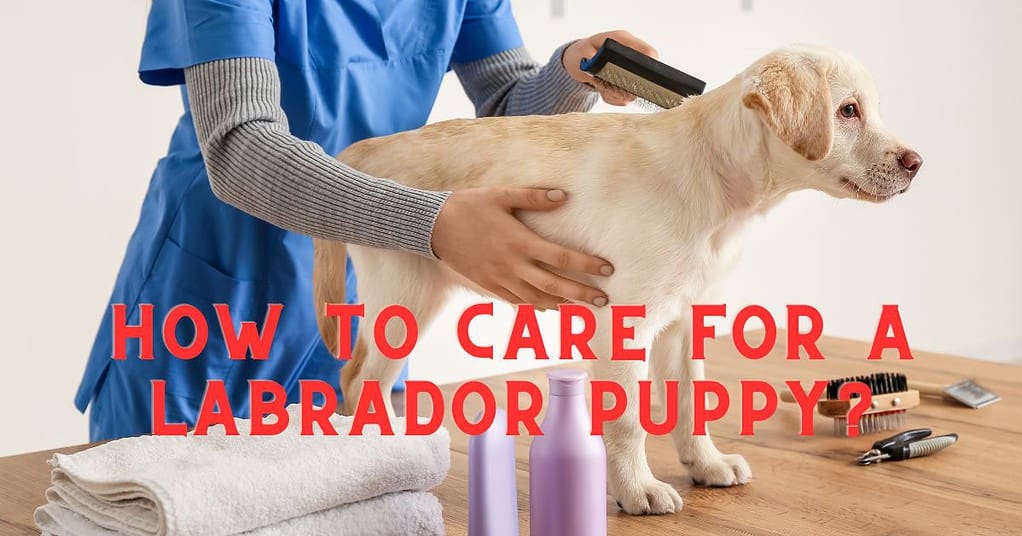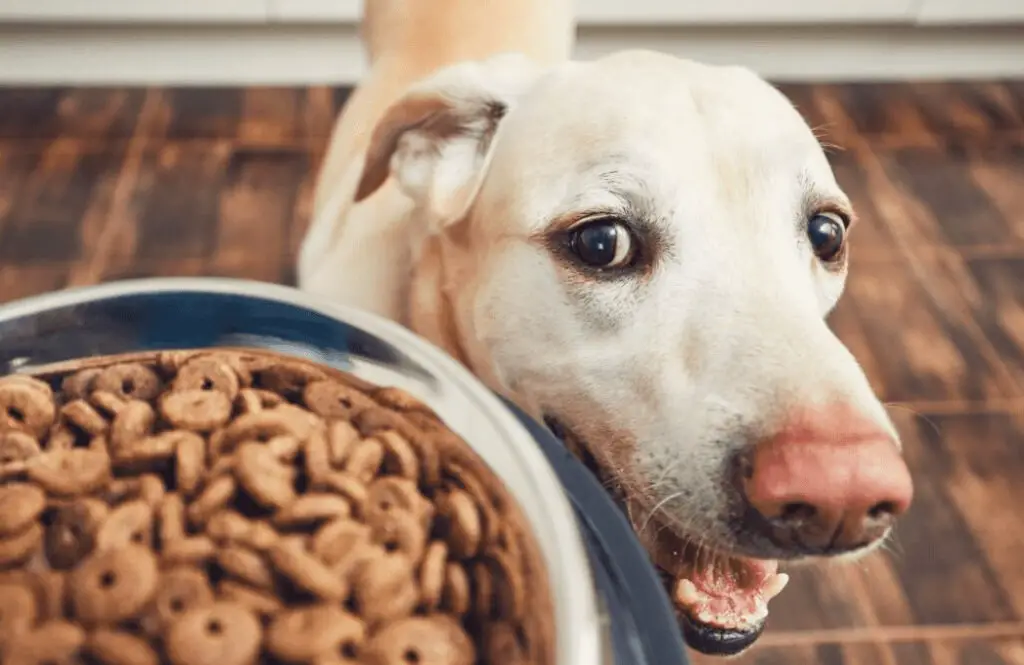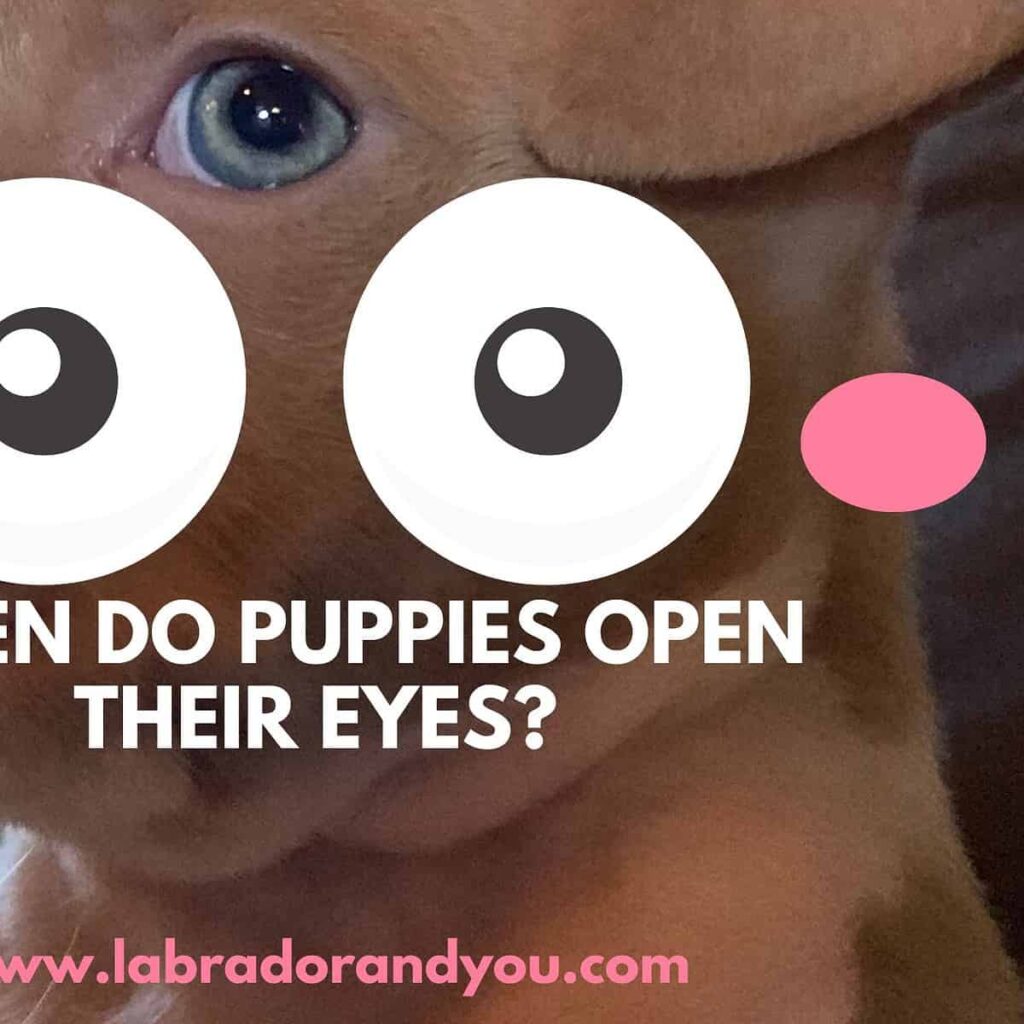When you bottle feed a puppy, it’s important to use a specifically formulated puppy milk replacement and sterilize all equipment. Feed at the same time each day and allow the puppy to nurse slowly. Hold the bottle at a 45-degree angle to prevent air ingestion. Puppies need to be fed every 2-4 hours.
After each feeding, burp the puppy by gently massaging its back. Make sure the milk replacement is warmed to 100-105°F. Keep a routine to ensure the puppy is getting adequate nutrition to develop.

When to Use Formula to Bottle-Feed a Newborn Puppy?
There may be instances when puppies require formula feeding such as maternal rejection, sick mother dog, inadequate milk supply, or if the puppy is orphaned, and knowing how to carry out this task safely becomes essential.
Do all puppies need formula?
Not every puppy needs formula. Puppies who can drink from their mom do not need it. Mom’s milk is the best food for them. But some puppies are in a different spot. If mom doesn’t have enough milk or if she gets sick, they will need help.
These puppies may also need formula if she says no to them. A vet can tell you what to do. They know if your puppy needs formula or not.
Factors to Consider Before Bottle-Feeding a Puppy
Understanding the reasons for needing to bottle-feed a puppy, such as maternal rejection or health complications, is crucial in ensuring their survival and growth. Dive into these factors to ensure you’re fully equipped for this responsibility.
Mother’s rejection
Mother’s rejection can be a sad part for newborn puppies. Some moms may not want to feed their babies. They may leave the pups alone too often. This is called maternal abandonment.
The puppies are then seen as orphaned pups. In this case, bottle-feeding is needed. It makes sure that these little ones get all they need to grow well and strong. Hand-feeding with a nursing bottle becomes important here.
It plays a helping hand in nurturing the puppy back to health.
Health issues
Sick puppies don’t drink milk from their moms. They might feel weak and lose weight fast. This is a health issue you need to check for before bottle-feeding a pup. A vet needs to see such pups right away.
You can keep the puppy healthy by feeding it with a bottle after that. Bottle feeding helps weak or sickly pups get better. Do take care not to overfeed them as it could cause other problems.
Lack of milk production
Milk shortage is a serious issue in mother dogs. It can stop puppies from growing well. Many things cause this problem. Sometimes the mother dog’s body has trouble making milk. This is called low lactation levels.
Other times, the mommy dog might have enough milk but can’t feed her babies right. We call this nursing difficulties or bad nursing ability.
4 Best Milk Replacers for Bottle-Feeding Puppies
Revival Animal Health Breeder’s Edge Foster Care Powdered Milk Replacer
The Revival Animal Health Breeder’s Edge Foster Care Powdered Milk Replacer is a top choice for bottle-feeding puppies. It provides complete and balanced nutrition. Using the newest findings in dog food science, this puppy formula has unique ingredients.
It is perfect for young dogs in their first 35 days of life. The milk replacer meets all their diet needs. But it also works well for pregnant or nursing dogs who need extra support with food.
One great thing about this product is that it won’t cause diarrhea in puppies, which is common with other types of milk replacers. This makes it a trusted product among many dog owners.
PetAg Esbilac Puppy Milk Replacer Powder
PetAg Esbilac Puppy Milk Replacer Powder is a top pick for feeding puppies. It has things that are good for puppies’ health. This powder is like real mother’s milk. The formula helps orphaned, nursing or rejected puppies grow up healthy and strong.
You can feed it to your pup from birth to six weeks old since it easy for them to digest and they will like the taste too! To make this puppy food, mix one part of the powder with two parts warm water.
It’s easy and quick! People love PetAg Esbilac Puppy Milk Replacer Powder so much that it is the best-selling puppy milk replacer on the market!
PetAg PetLac Puppy Milk Replacement Powder
PetAg PetLac Puppy Milk Replacement Powder is great for little dogs. It acts like a mom dog’s milk. Made with the right stuff, it helps puppies grow well and strong. This puppy milk powder has good things like vitamins and minerals in it.
Puppies can eat this until they start eating food on their own. A small amount of the powder can go a long way when you mix it by weight for weaned pups. The powder comes in a 10.5 oz size but there’s also liquid form available just for newborn to six-week-old puppies.
GNC Pets Ultra Mega Premium Milk Replacer Goat’s Milk Puppy Powder Formula
GNC Pets Ultra Mega Premium Milk Replacer Goat’s Milk Puppy Powder Formula is a great choice for your puppy. This milk replacer comes from all-natural, whole goat’s milk. It helps your puppy grow strong bones and healthy teeth.
The formula backs up the immune system of your puppy too.
This product has good stuff like prebiotics and probiotics along with important vitamins and minerals. It feeds the same amount of protein, fat, and carbs found in regular milk to puppies.
If you have kittens at home as well, there is also GNC Pets Ultra Mega Premium Milk Replacer Powder Formula for them! This goat’s milk boosts growth in kittens thanks to natural milk proteins.
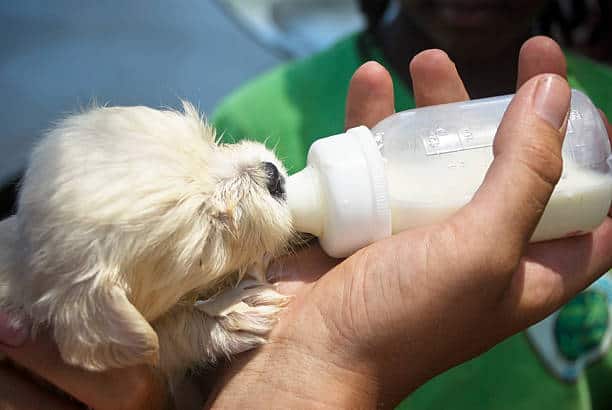
How to Bottle-Feed a Newborn Puppy?
Learn the art of preparing puppy formula, selecting the suitable feeder, correctly positioning the little pup for feeding sessions and helpful tricks for aiding their digestion process.
You’ll become a master in bottle-feeding in no time with these comprehensive steps; keep reading to discover more!
Preparing formula
First, get the right milk replacer for your puppy. Then read and follow the mixing directions on the package. Use warm water to mix with the powder. This helps it blend in better. Make sure you have just enough for 24 hours of feeding time.
This will keep it fresh and good for your puppy to drink up! If there is any leftover after a day, throw it away so your pup only gets the best!
Choosing the right feeder
Picking the right feeder is a key part of bottle-feeding a newborn puppy. You should use small pet nursing bottles or pet nurseries. These are made for puppies who can’t feed from their mothers.
They are perfect for orphaned, left-alone, or weak puppies too. The nipple on these bottles is just the right size for a puppy’s tiny mouth. It helps them eat easily and safely. But be careful when you mix and give puppy milk replacer in these bottles.
Follow all the steps well to keep your pup healthy.
Positioning the puppy
Make sure the puppy is in the right spot before you feed it. The pup should lie on its belly, not upright or on its back. This keeps them safe when they drink milk. It’s best to have them lie down on your lap or a flat table top.
Using a baby bottle may seem like a good idea, but it’s unsafe for puppies. A wrong move can hurt their ear and make them yelp in pain. Always check if you’re doing it right by gently pinching their ear and seeing how they react.
Burping and helping with digestion
Puppies need burping when bottle-fed. This helps keep air out of their little bellies. Too much air can cause pain and belly issues. Puppies should be helped to burp halfway through each meal.
To do this, gently pat the pup’s back until you hear a small burp. Do not tip the puppy’s bottle up while they suckle — it may make them swallow more air than necessary! Burping is very helpful for your puppy’s comfort and digestion.
How Many Formulae Do Puppies Need?
Understanding the quantity of formula for your puppies is essential; this section will highlight the feeding schedule, how much formula to use based on weight and age, and signs that indicate if your puppy is getting enough nutrition from the milk.
Feeding Schedule
Puppies need to eat a lot. Feed them every 2-4 hours each day. This is the puppy feeding schedule. If a pup has no mom, feed it 4-5 times each day for the first two weeks. It does not matter if you use a bottle or tube for feeding, do it 4 times daily.
Each time should be about 3 to 4 hours apart from the last one. A small pup that weighs six ounces needs around 3.75 ml of formula per mealtime.
Amount of formula based on weight and age
Feeding a puppy with the correct amount of milk formula based on its weight and age is crucial for its growth and development. Below is a detailed table that serves as a guide:
| Age of Puppy | Weight of Puppy | Amount of Formula per Feeding | Calories Needed per Day |
| 1 Week Old | 1-2 lbs | 15 ml per 2 oz of body weight | 20 kcal/100 g body weight |
| 2 Weeks Old | 2-3 lbs | 15 ml per 2 oz of body weight | 20 kcal/100 g body weight |
| 3 Weeks Old | 3-4 lbs | 4 ml/100 g body weight | 3.5-3.75 calories per ounce of body weight |
| 1 Month Old | 4-6 lbs | 4 ml/100 g body weight | 3.5-3.75 calories per ounce of body weight |
Signs if the puppy is getting enough milk
Puppies act happy and full when they get enough milk. Their bellies round out, but not too much. They also sleep a lot after feeding. This is a sign that they are growing well.
Your puppy’s belly may get too much milk if it looks too round or tight. This can lead to sickness like throwing up or diarrhea. To fix this, try giving less milk at each feed time.
On the other hand, puppies that don’t get enough milk cry a lot and move more than normal. They might look thin and weak as well. If you see this happen, give them more milk during feed times.
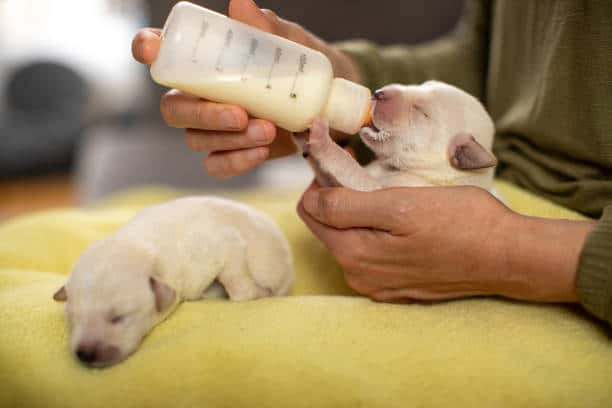
Nutritional Guidelines for Bottle-Feeding Puppies
Discover how to create a homemade puppy formula, learn about the key ingredients required and follow step-by-step preparation instructions, ensuring your pup gets all necessary nutrients for optimal growth.
Homemade puppy formula recipe
You can make your own puppy milk at home. Use canned evaporated milk or whole goat’s milk, sterilized water, and raw egg yolk. Add some plain yogurt as well. Mix all the parts until smooth.
This homemade puppy formula is full of good stuff for a young pup! It has about 3.5 to 3.75 calories for each ounce of the pup’s weight every day up to four weeks old. Other recipes might use fresh goat’s milk, mayonnaise, and light corn syrup instead of evaporated cow’s milk and yogurt.
You can switch it around based on what you have in hand.
Ingredients and directions
You need some items to make the puppy food. Honest Kitchen dehydrated food, meat and some special things that help a dog grow are put in it. For a homemade recipe, you use canned evaporated milk or whole goat’s milk, sterilized water, raw egg yolk, and plain yogurt.
Now let us learn how to do it. Mix all these ingredients together for the best meal for your baby dog. A small pet nursing bottle is good for feeding them this mix. Follow what the milk replacer’s label says about how much to give them and when to feed them.
This will help your puppy grow strong and healthy!
Raising Orphaned Puppies
Learn about the common challenges in raising orphaned puppies, like hypothermia, dehydration, and hypoglycemia, and gain valuable insights on how to care for these vulnerable newborns properly.
Chilling and hypothermia
Orphaned puppies face a big risk of chilling and hypothermia. Their bodies lose heat quickly, faster than those of older dogs. This can be really dangerous for them. In fact, many newborn puppies die because they get too cold, also known as hypothermia.
To help keep these puppies warm, we can use different things like incubators, heat lamps or heating pads. Hot water bottles also work well in providing warmth to the puppies. Checking their temperature via rectal thermometer is key so that we know if they are getting too cold and need some extra warmth to stay alive!
Dehydration
Dehydration can be dangerous for young puppies, especially those without a mother. They can lose water quickly if they are not nursing or if it’s too hot where they live. If pups don’t get regular milk from their mother or a bottle, dehydration sets in fast.
Even being in a place with low air moisture can cause it! To keep puppies hydrated, use a good milk replacer and make sure they drink often. Also, monitor the room temperature so the pups don’t overheat.
Don’t rush feeding times and never feed cold formula as this may also lead to dehydration among puppies.
Hypoglycemia
Orphaned puppies can sometimes suffer from hypoglycemia. This is a scary illness where the puppy’s blood sugar gets too low. Puppies with hypoglycemia may not want to nurse, or they might act very tired and depressed.
Sometimes pups with this condition can have shakes or even fits.
Puppy caretakers must watch for signs of this illness when bottle-feeding young dogs. To stop hypoglycemia, the puppy needs enough food at all times. Dehydration also ties in closely with low blood sugar levels in puppies – so they must get enough water as well as food.
If symptoms persist, you should seek veterinary treatment right away.
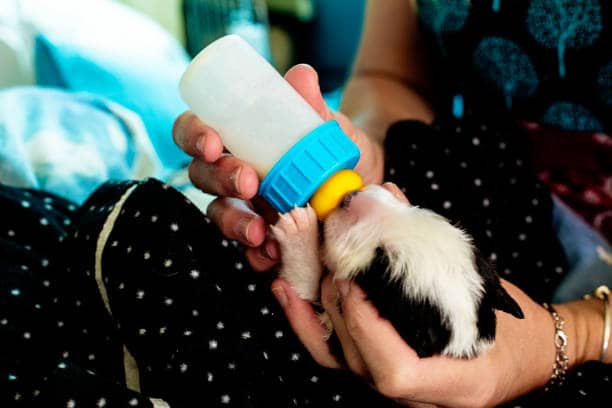
Weaning and Transitioning to Solid Food
This section will guide you on when it’s the right time to start weaning your puppy, how to introduce them to solid food gradually, and provide a helpful weaning chart for reference.
We’ll also touch upon feeding amounts during transition and signs of readiness you should look out for in your puppy.
When to start weaning
Puppies are ready to start the weaning process at 3-4 weeks old. This is when their teeth begin to show up. The new tiny teeth mean they can now start trying solid food. It’s important to move slowly, though.
You want to ensure your puppy does not get upset tummies from eating too much solid food too fast. Just like babies, puppies go through small steps in moving from milk to other types of foods.
Introducing solid food
As puppies grow, they start eating solid food. This change is part of puppy development and is called weaning. In this stage, you slowly add small bits of solid food to their diet.
It helps to build a strong digestive system. Do this carefully so the puppy can eat without trouble. At first, only feed a little solid food mixed with milk replacer in a bowl. Over time, give more solid food and less milk replacer until the puppy eats only dry or wet dog food from the bowl by itself.
Bottle feeding may still be needed to help puppies adjust to eating solids while still getting enough nutrients from the milk replacer.
Weaning chart
Weaning is a gradual process that should begin around the third week of a puppy’s life. The following weaning chart provides a suggested timeline and can guide the transition from formula to solid food.
HTML
| Age | Milk Formula | Gruel Mixture | Solid Food |
| Week 3 | Continue as normal | Begin Introduction | Not yet introduced |
| Week 4 | Reduce gradually | Increase quantity, decrease liquidity | Not yet introduced |
| Week 5 | Feed minimally or stop | Continue as normal | Begin Introduction |
| Week 6-8 | No longer necessary | Reduce gradually | Increase quantity |
| Week 9 | No longer necessary | No longer necessary | Continue as normal, puppy should be fully weaned |
The above chart outlines a typical weaning process for a puppy.
- In week 3, the gruel mixture is introduced while the puppy still drinks milk formula. The gruel mixture is a blend of milk formula and solid food, initially with a high ratio of milk.
- By week 4, the milk formula intake is reduced, and the liquidity of the gruel mixture is decreased as well.
- By week 5, solid food is introduced while the milk formula is further reduced or stopped altogether.
- From weeks 6 to 8, the puppy should consume more solid food and less gruel mixture.
- By week 9, the puppy should be fully weaned and consuming only solid food.
Remember, weaning is a gradual process and requires patience. Any sudden changes in diet may cause digestive problems.
Conclusion
Bottle feeding a puppy can be fun and rewarding. It means you are giving them a chance to grow strong and healthy. Always give them the right amount of milk at the right times. And don’t forget, they need your love just as much as they need their meals!
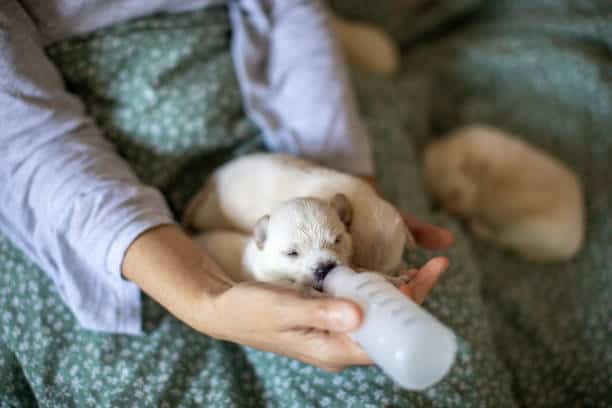
FAQs on how to Bottle Feed A Puppy
1. How Often Should I Bottle Feed A Puppy?
Puppies need to be bottle fed every 2-4 hours, around the clock in the first few weeks. Spread feedings evenly throughout the day and night.
2. What Temperature Should The Milk Replacement Be?
Warm the milk replacement to 100-105°F. Test on your wrist that it’s not too hot before feeding.
3. How Much Should I Feed Per Bottle?
Follow instructions on the milk replacer packaging based on the puppy’s weight. Start with smaller amounts and increase as needed.
4. How Do I Get The Puppy To Take The Bottle?
Gently insert nipple into the puppy’s mouth and stroke its throat to encourage suckling. Don’t force the nipple.
5. Is Burping Necessary?
Yes, gently burp the puppy after feeds by massaging its back. This prevents gas and spit up.
6. What Milk Replacement Products Can I Use?
Use only commercial puppy milk replacers recommended by your vet, not cow’s milk or human formulas.
7. How Do I Clean Bottles And Nipples?
Sterilize all equipment used for each feeding. Wash in hot, soapy water then sterilize using boiling water or steam.
8. Can I Overfeed A Puppy With The Bottle?
Yes, only give the recommended amount and watch for signs your puppy is full like refusing the bottle.
9. What If The Puppy Won’t Take The Bottle?
Try gently rubbing its mouth or throat, repositioning the bottle, or bringing formula to room temp. Consult a vet if needed.
10. When Do I Switch From Bottle To Solid Food?
Around 3-4 weeks old, start introducing puppy food soaked in warm formula. Slowly decrease formula over the next few weeks.
Author Profile

- Product Reviews Specialist and Cofounder
-
Labradors have an extraordinary capacity for love and companionship, and my mission is to help you unlock their full potential. Hi there! I'm Sarah, a proud contributor to Labradorandyou, the go-to online resource for all Labrador Retriever enthusiasts. As a lifelong owner and avid admirer of these remarkable dogs, I bring a wealth of knowledge and hands-on experience to our readers.
One of my strongest beliefs is in the power of positive reinforcement training. I'm truly passionate about helping our readers build strong, positive relationships with their Labradors. Whether you're a first-time owner or a seasoned Labrador enthusiast, I aim to provide you with the resources and guidance to cultivate a bond that will endure a lifetime.
Also by the author
 FAQNovember 17, 2023Why Is My Dogs Poop Yellow? 8 Reasons & Solutions
FAQNovember 17, 2023Why Is My Dogs Poop Yellow? 8 Reasons & Solutions ReviewsNovember 17, 2023Hill’s Science Diet Review [ Detailed ]
ReviewsNovember 17, 2023Hill’s Science Diet Review [ Detailed ] PuppyNovember 16, 2023How To Bottle Feed A Puppy? Facts You Can’t-Miss
PuppyNovember 16, 2023How To Bottle Feed A Puppy? Facts You Can’t-Miss FAQNovember 16, 2023Why Do Dogs Dig On Carpet? Complete Guide
FAQNovember 16, 2023Why Do Dogs Dig On Carpet? Complete Guide
